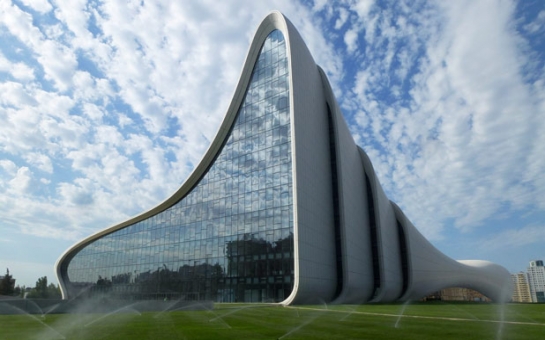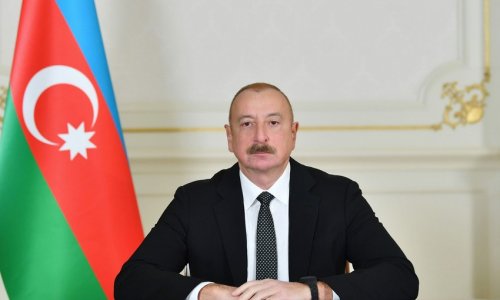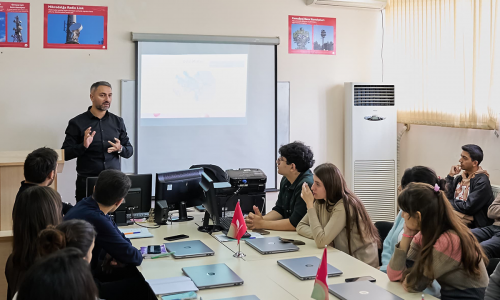Baku, Azerbaijan's capital on the shores of the Caspian Sea, has up until recently been known primarily as a city growing rich on oil and natural gas.
That's if people can find it on the map at all. This small country, which was until the 1990s part of the Soviet Union, is rather off the beaten track, sharing borders with Russia, Georgia, Armenia, Turkey and Iran.
Azerbaijan is in the world's top 20 oil-producing nations as well as owning one of the world's biggest natural gas fields. The country has literally oozed oil - traveller Marco Polo observed in the 13th century that the oil was not good to eat but burned well and was also very useful for camels suffering from itchy skin conditions. Natural gas spontaneously combusted, providing ready fuel for the temples of the fire-venerating Zoroastrians whose religion once dominated the region.
Today, the flow of oil is carefully controlled and it is high performance sports cars and Hummers rather than camels that help to consume local supplies. But what Baku the capital still oozes is money; lots of it.
Baku comes as something of a shock to travellers imagining an exotic East meets West crossroads; a place of caravanserai and mosques blended with European and Russian-inspired architecture. And yes, there are elements of this blurred boundary between cultures and religions, but Baku is an increasingly sophisticated city that appears nowadays to be looking more to the West than to the East.
Oil has been traded in Azerbaijan since at least the 3rd and 4th centuries but it wasn't until the late 19th century that the country began to experience its first boom, which brought with it grand buildings, mansions and parks. By 1901 the country was producing half the world's oil supplies. The world's first oil field was developed here and the world's first tanker was constructed here to ferry oil supplies into the heart of the Russian empire. This was the work of the Nobel brothers no less (Ludvig, Robert and Alfred, the latter the founder of the Nobel prizes).
During World War II, the Azeri oil fields kept almost the entire Soviet war effort fuelled and were thus a prime target for invasion by Hitler's forces. So sure was the German military hierarchy that they would achieve this, the story goes, that they presented Hitler with a cake representing the region and gave him the piece featuring Baku. However, Hitler didn't get the chance to have his cake and eat it as the German forces were eventually driven from the region.
Today the ever-growing flow of oil money has helped fuel extensive renovations and restorations of its historic city centre (parts of which date back to seventh century) and of its 19th century European and Russian-influenced buildings that were constructed during the early days of oil exploration.
Oil money is also funding a whole new wave of construction; hundreds of new apartment blocks are springing up beside the Caspian, there are shopping malls and boutiques sporting all the big brand names but there are also some jaw-dropping examples of cutting-edge innovative architecture among this.
The Flame Towers, a trio of 190m tall skyscrapers that were completed in 2012 at an estimated cost of about US$350m, are Azerbaijan's most visible symbol of its newfound prosperity. The buildings with their graceful curves are stunning by day but are simply spectacular in the evenings when for about two hours their glass flanks are transformed into giant illuminated screens.
Azerbaijan's red, green and blue flag flutters across the towers' surfaces, athletes appear to leap from building to building but most breathtaking of all is when all three appear to catch fire, with tongues of fire leaping from ground level to tip.
But the towers now have some competition with the opening just last year of the Heydar Aliyev Center (sic).
At a mere 74 metres this building does not dominate Baku's skyline . . . one comes across it nestled among much taller structures. But from every angle, at any distance, it demands and gets attention.
Clad in white fibreglass reinforced concrete panels the building flows seamlessly from plaza to pinnacle, rather like a fold in an oriental rug. Stand outside and there's no clear delineation between being beside or actually on the building. Vast glass curtain walls illuminate the interior which is just as fluid as the exterior.
The building was designed by British-Iraqi architect Zaha Hadid. Hadid was awarded the Nobel prize equivalent of architecture in 2004 and in 2010 Time magazine named her as one of the world's most 100 influential people. (Among her portfolio is the aquatic centre constructed for the London Olympic Games).
No-one I spoke to in Baku has any idea how much this astonishing building cost.
"They (the authorities) don't want to tell the people because it is so much money that many Azeris think should have been spent on more necessary things like education and health and development in our countryside," I was told by one Baku resident. "We think it must be billions."
The centre is named after Hedyar Aliyev who, from 1969 to 1982, was the leader of the Soviet republic of Azerbaijan, (after many years as a senior officer in the KGB). Following the collapse of the Soviet Union and Azerbaijan declaring its independence he reinvented himself to serve as president from 1993 to 2003. A significant number of former Soviet leaders managed the transition from Communist Party secretaries (leaders) to presidents of capitalist-leaning and democratic (albeit more in name than in practice) nation. Aliyev died in 2003 after controversially naming his son Ilham as his party's sole presidential candidate (Ilham duly won the next election).
As one walks around the building with its flowing lines and soaring interiors it's hard not to struggle just a little to relate this architectural sense of freedom to a leader known for his strong-arm tactics and rumours of human rights abuses.
Inside the centre is an auditorium for concerts, a meeting hall and a cultural museum. The latter features a small but beautiful array of Azeri costumes, musical instruments and other items but it's the white monochrome surfaces, the sweeping staircase that seems more organic than concrete and the curved ceiling with it inset streaks of light that steal the show.
The day I visited, few locals were to be seen . . . the few of us wandering, mouths open, around the spaces were dwarfed by our surroundings. The white interior wrapped around us, floors merging into walls that swept overhead to become the ceiling. I felt like an extra in 2001: A Space Odyssey.
A ROAD TO A PLACE LESS ORDINARY
Coming from a country with relatively insignificant oil and gas deposits, Kiwis find Baku and its environs a fascinating place.
While Middle Eastern visitors or Texas oil barons might find it all a bit ho-hum, the sight of nodding donkeys sucking up black gold from oil wells, in some cases literally from people's backyards, is an arresting one.
Drive south away from the restored 19th century facades of Baku, past the Crystal Hall that was constructed as the venue for Azerbaijan's hosting of the 2012 Eurovision Song Contest, and you can practically smell the oil.
The road south, towards the border with Iran, hugs the coast where enormous off-shore oil platforms are repaired. They lie on their sides like giant beached Meccano whales, the landscape around them a wasteland of desert scrub and rubble.
Crumbling and desolate factories and attendant apartment blocks, built during the Soviet era and now abandoned, dot the landscape. Incongruously among this almost post-apocalyptic scene luxury villas are popping up and monumental stone walls border Caspian Sea resorts in the making. It's hard to imagine anywhere less attractive for a resort than this shoreline with its almost perpetual wind and oil-filmed waves but no doubt heavy capital investment in imported palms and possibly even sand might work miracles.
If you drive inland and into the hills there's an even more astonishing sight. One hundred and twenty kilometres out into the Caspian, linked to the mainland and still officially inside Baku's city limits, is the world's first off-shore oil well, known as Oily Rocks.
From the hills on a clear day one can see the network of causeways, 300 kilometres of them. They sit on foundations formed by sinking ships 1000 metres on to the sea bed. The field was developed by Soviet leader Josef Stalin in 1949 and there are about 250 wells linked by the causeway system.
Out there in the haze and the Caspian winds about 2000 people live and work on week-long shifts. Entry to the causeways is very tightly controlled, no casual visitors are allowed.
"There are many foreign workers out there, along with Azeris," explained my Azeri friend. "They all do the same work but the foreign workers get paid twice as much if not more than the local men."
- The Timaru Herald
Bakudaily.az











